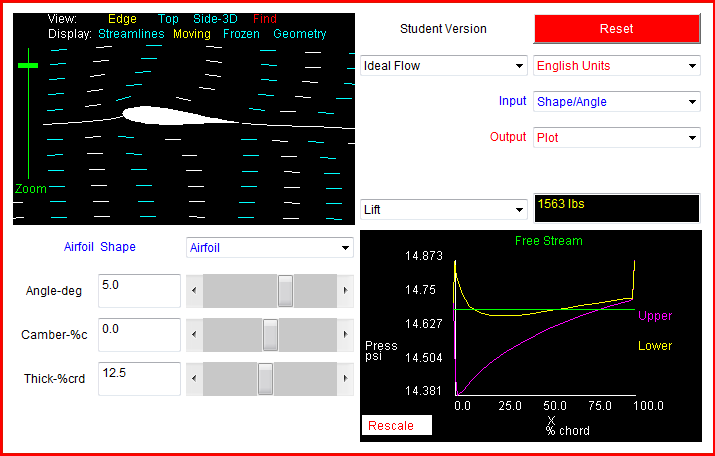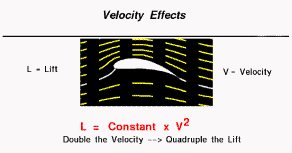Velocity Effects
Investigating the effects of velocity on Lift

Velocity Effects
Directions
Print the worksheet page before starting the project if the teacher hasn't already printed them for you. (Print it double sided if possible.)
Then, for each of the tables below:
- Determine the square of each velocity.
- Enter your answers in the tables in the second column.
- Go to the FoilSim applet
page.
Click the Reset button to set the following conditions:

Change the Angle-deg value to 0.0 and hit the ENTER key.
Change the Camber-%c at 0.2.
Change the Thick-%crd value to 15.0 and hit the ENTER key.
The screen should now look like this:
Change the
Leave the Speed at 100.0 until we start entering in the values from the tables.
Leave the Altitude-ft at 0.0.
The screen should now look like this:

Leave these values (except for velocity) the same for all of the wing planforms in the tables.
Change the
Input option again... this time to Size.Change the AR correction to on.
The screen should now look like this:

For each of the three wing planforms in the table do numbers 1 - 5:
- Change the Chord-ft value to the value you had in column four of the Wing Areas Worksheet. Hit the ENTER key. Copy that value to the table for the current wing planform.
- Change the Span-ft value to the span value you had in column three of the Wing Areas Worksheet. Hit the ENTER key. Copy that value to the table for the current wing planform.
-
Change the Area-sq ft to the value you put in the column for Area of
Two Wings of the Wing Areas Worksheet.
Hit the ENTER key. Copy that value to the table for the current wing
planform.
{Remember: Lift and Area are directly proportional.
If the area is over 1000 sq ft, then divide area by 100, the span by 10 and the chord by 10 and enter those numbers.
When you get the lift, multiply it by 100 to get the real value!} - Change the

-
Keeping in mind that the Lift is directly proportional to the square of the Velocity,
calculate and record the Constant for each entry in each table.
Worksheet
Wright Brothers |
Area of two wings: |
Span of two wings: | Chord of one wing: |
Velocity: |
Velocity2: |
Lift: |
Constant: |
0 |
|||
25 |
|||
50 |
|||
75 |
|||
100 |
|||
125 |
|||
150 |
|||
175 |
|||
200 |
|||
225 |
|||
250 |
|
F-18 |
Area of two wings: |
Span of two wings: | Chord of one wing: |
Velocity: |
Velocity2: |
Lift: |
Constant: |
0 |
|||
25 |
|||
50 |
|||
75 |
|||
100 |
|||
125 |
|||
150 |
|||
175 |
|||
200 |
|||
225 |
|||
250 |
Area of two wings: |
Span of two wings: | Chord of one wing: | |
Velocity: |
Velocity2: |
Lift: |
Constant: |
0 |
|||
25 |
|||
50 |
|||
75 |
|||
100 |
|||
125 |
|||
150 |
|||
175 |
|||
200 |
|||
225 |
|||
250 |
Student Names: __________________________________________________________________________
| Questions: | Answers: |
| Are the constants exactly the same for all entries in each individual table? Why or why not? List possible sources of error. | |
| Are the constant values the same for each aircraft? Discuss and list some reasons for this. | |
| Which values were kept the same in FoilSim for all aircraft in this activity? | |
| Which values in FoilSim differed from aircraft to aircraft in this activity? | |
| The "Constant" values you calculated come from the values that are held constant (not changed). Now, which values do you think are included in the "Constant" value for each aircraft? | |
| Could these values ever be considered variables? If so, when and how? If not, why not? | |
|
Now, suppose
your
aircraft from the Wing Areas worksheet
is loaded down with cargo and extra fuel for a long flight so that it weighs
12,500 pounds before takeoff. What speed will it need to acquire before it has enough lift to get airborne? {Hint: On the ground the altitude and angle are both zero. Also, use 0.5 for the camber and 15.0 for the thickness.} |